ANGLO BOER WAR: REMEMBERING THE FOREIGN VOLUNTEERS (3)
Description
In this article we remember the following foreign volunteers fought on the Boer side: Andries Smorenburg, Colonel de Villebois-Mareuil and Count Harra von Zeppelin. A short life description of each is given.
Keywords
- Andries Smorenburg,
- Colonel George Henri Anne-Marie Victor de Villebois-Mareuil
- Count Harra von Zeppelin.
- St Helena
- Elandslaagte
- Heidelberg
- Boshof
ANGLO BOER WAR: REMEMBERING THE FOREIGN VOLUNTEERS (3)
Jennifer Bosch

Andries Smorenburg
Andries Smorenburg originally from the Netherlands, journeyed to South Africa around 1887, seeking greater fortune. He was later joined by his cousins, Jan Willem and Herman Hendrik Smorenburg, who came to support the Boers in their struggle for freedom against British colonial forces during the Second Anglo-Boer War (1899–1902). Andries became the Commandant of the Second Dutch Foreigner Unit, and he, along with Jan, was captured at the Battle of Boshof in April 1900. Both were sent as prisoners to Deadwood Camp on the remote island of St Helena.
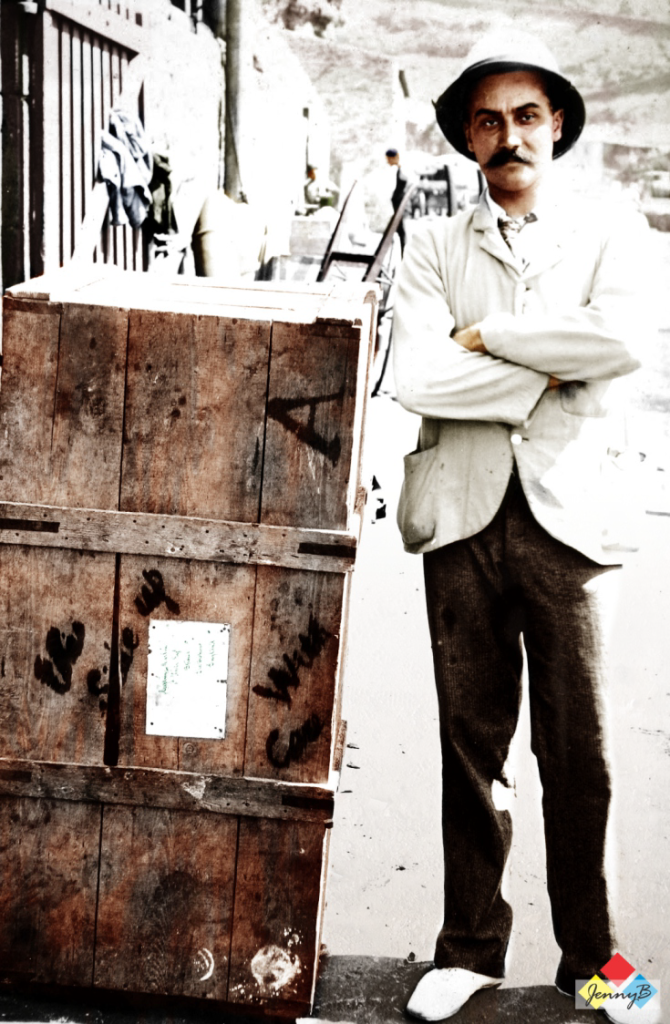
Herman was captured separately and sent to Ceylon as a POW.
While on parole at Deadwood Camp, Andries orchestrated an extraordinary escape attempt. He built a wooden crate, outfitted with supplies and labelled with false sender and recipient information, aiming to mail himself to England disguised as luggage. On 20 December 1901, he left the camp, located his crate at Jamestown harbour, and boarded the SS Goth, evading detection for several days. However, on Christmas Day at Ascension Island, a sailor noticed something amiss in the ship’s hold; Andries was discovered and handed back to authorities.
After being returned to St Helena, Andries was court-martialled for abusing his parole and attempting escape and imprisoned at Fort High Knoll until the war’s conclusion. Upon agreeing to sign allegiance to the British Crown, he was eventually allowed to return to South Africa. The story also notes alternative versions of his discovery: one suggesting a rollcall at Deadwood Camp led to a search at Ascension Island, and another claiming he was betrayed by a Dutchman. Today, the crate used in his famous escape bid is exhibited at MuseumAfrica in Johannesburg.
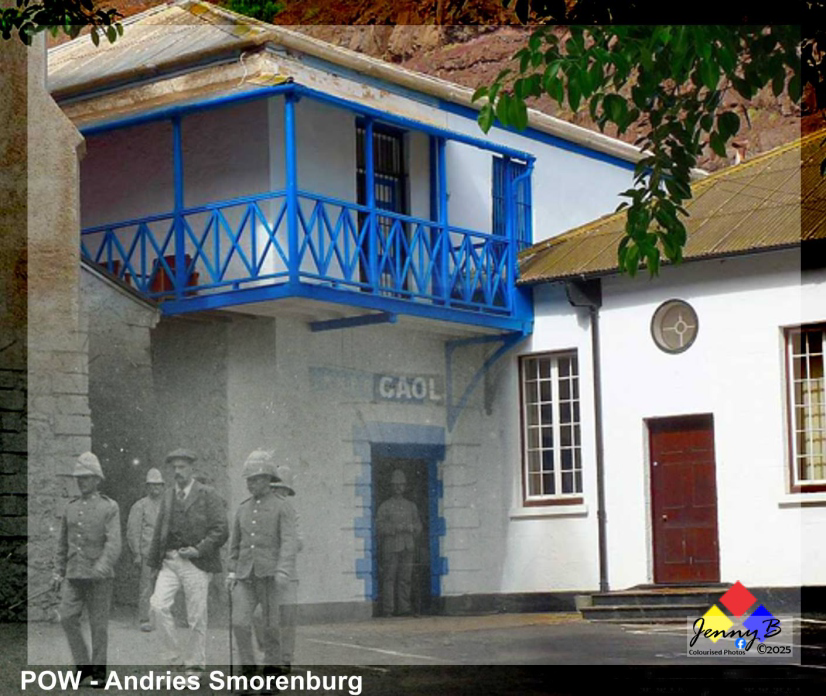
St Helena Jail – THEN AND NOW
Sources: re-worded from: altathegenealogist.org.za/individual-surnames-familylines/smorenburg/andries-smorenburg-1872-1939/
POW Andries Smorenburg made a crate for himself, marked “Curios”, Handle with Care” and “This Side Up” and then “mailed” himself from Saint Helena on the Union Castle Mail Ship SS Goth. He prepared his crate by labelling it with a false address in Stroud, Gloucestershire and then packed it with clothing, matches, and enough food and water for 20 days. Armed with a rough map of Southampton dock, he climbed inside and was loaded aboard. Despite his labels the crate was tossed about and overturned on board Smorenburg was concussed and lost most of his water. He was discovered by Captain John Attwood on Christmas Day 1901 when the ship was at sea, landed at Ascension, handed over to the authorities and returned to St. Helena.
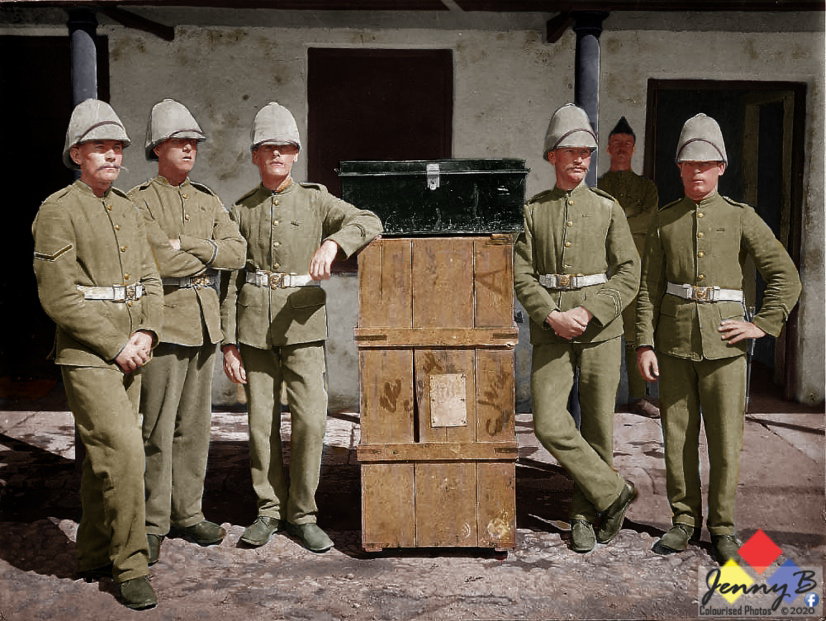
Andries Smorenburg’s wooden crate which he built on St Helena. He tried to escape using it but was caught and returned to St Helena
Colonel de Villebois-Mareuil

George Henri Anne-Marie Victor de Villebois-Mareuil was born just South East of Nantes. He completed military education graduating as 2nd Lieutenant in 1867. He then joined the Marine Infantry and was promoted to Lieutenant in 1870. Back in France he was instrumental in liberating the city of Blois from the Prussians. There he was wounded. He spent 9 months in hospital, was later decorated and promoted to Captain. By 1889 he was already a Major and 3 years later a Colonel, being the youngest Colonel in the French army.
He arrived in Lourenco Marques on 22 November 1899 and General Joubert appointed him the rank of Major.
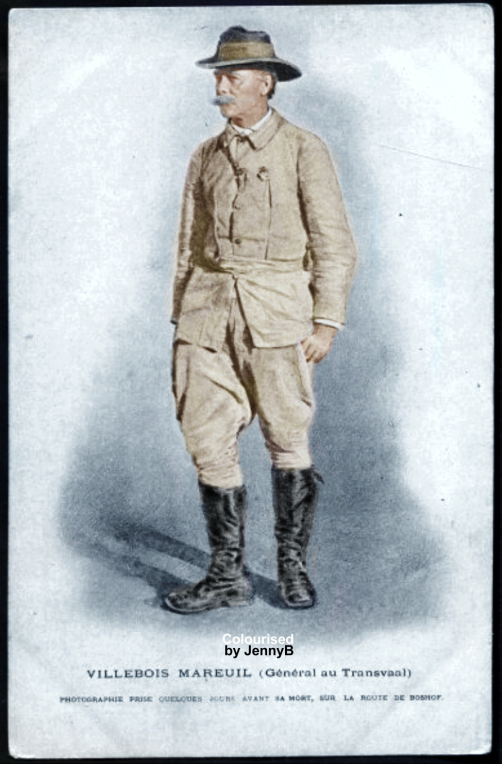
He fought at Colenso. He was betrayed by his assistant who informed the British troops of their position and died fighting on a hill on a farm named Kareepan near Boshof. He had 30 of his 300 men at his time of death. He was quoted as saying he would never surrender but wait for nightfall to escape the Maxim gun fire of the British Yeomanry under Methuen.
Just before his end he shot 2 or 3 British soldiers with his pistol, stood up in the heat of the battle encouraging his men on and was then shot in his back falling near an olive tree which still carries the bullet holes from the battle. He died on the 5th of April 1900.
A week after his death the Boer Foreign Legion was disbanded and its members absorbed under General de la Rey. His horse was transported to Britain by Lord Chesham and lived until 1911 and was buried on the village green in Latimer, Buckinghamshire next to the memorial commemorating those from the locality who had served in South Africa.
His remains were taken to Boshof where he was given a full military burial by the British.
Methuen paid for the burial from his own pocket. In 1971 his remains were exhumed, and his final resting place is in the Heroes Acre in Magersfontein.
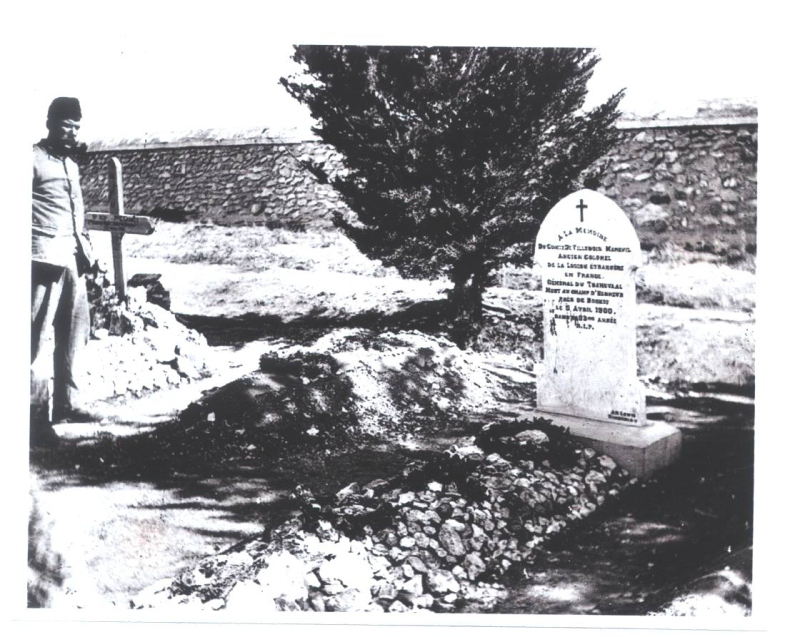
The grave of Col De Villebois Mareuil in Boshof, Free State.
A soldier of the 3rd Welsh Borderes looking on. A glass plate recovery by Nico Moolman.
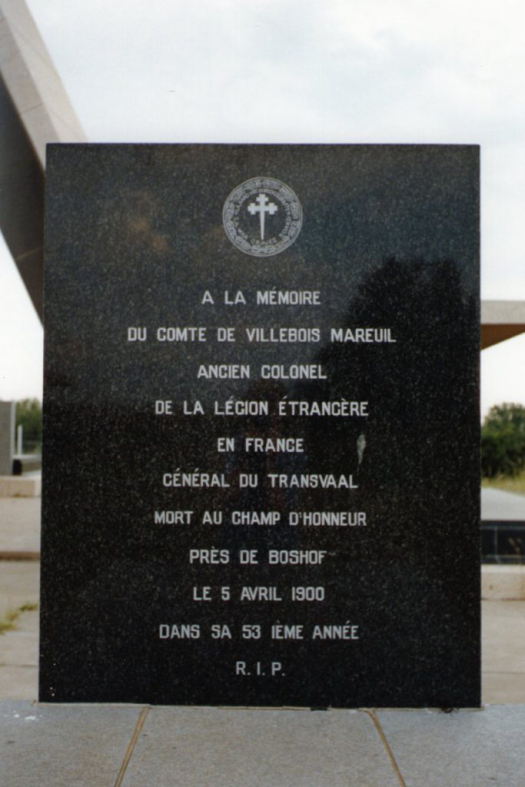
Comte de Villebois-Mareuil died near Boshof, 5th April 1900. Buried there with full military honours but was later moved to the Magersfontein Burgher monument.
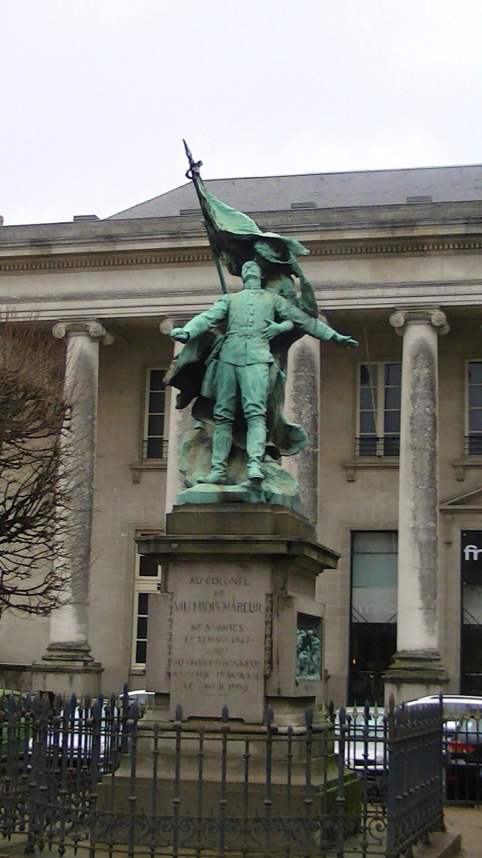
Statue of Georges de Villebois-Mareuil – Nantes, France
Sources:
• https://en.wikipedia.org/…/George_Henri_Anne-Marie…
• Bernard Lugan, La Guerre des Boers 1899-1902 (ISBN 2-262-00712-8)
Count Harra von Zeppelin
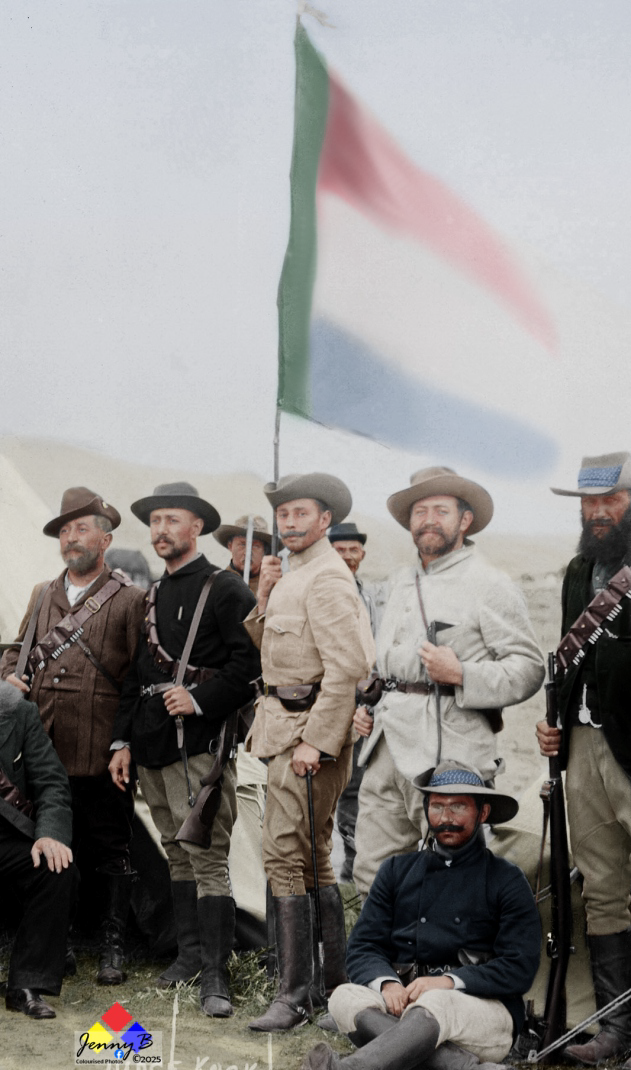
Elandslaagte and the German volunteers
During the Boer War, a German volunteer named Count Harra von Zeppelin, a relative of the airship pioneer Ferdinand von Zeppelin, served with a German commando. He was killed in action at the Battle of Elandslaagte on October 21, 1899, leading a charge against the Gordon Highlanders. His death, which occurred after he was shot and wounded by enemy cavalry,
was a notable loss for the German volunteers.
Colonel Schiel, who was by Zeppelin’s side when he received his mortal wound, wrote:
“Nevertheless, it was great!” were the last words of my Adjutant, the Count Zeppelin, who fell at my side. ….. A shell fragment had inflicted a mortal head wound”.
Early on Saturday morning, 21 October 1899, the battle began at Elandslaagte, the first big encounter in which the German Commando took part and in which it gave a gallant account of itself, despite being badly cut up and losing its wounded commander as a prisoner-of-war. The British force consisted of 3,000 infantry, mounted troops and artillery. The Boer force comprised of about 100 members of the German Commando, another 160 of the Hollander Corps, about 150 Free Staters of the Vrede Commando, and the remainder were from Johannesburg. They had only two guns which had been captured from Jameson.
The position, therefore, was about 800 Boers with two guns, against a British infantry and cavalry force of about 3,500 with 18 field pieces.
Part of the British force arrived at Elandslaagte at about 8 a.m. to the complete surprise of the Boers, many of whom were at the station. British reinforcements arrived at about 11 a.m.
The Germans had also lost heavily in encounters with the Dragoons. By 6 p.m. the British had overwhelmed the Boers’ position. The latter then began surrendering, but the majority mounted their horses and made for the Newcastle Road in a northwesterly direction. The Dragoon Guards and the Lancers, who had been kept in reserve, took up the pursuit of the retreating Boers who had left more than 1/3 of their number on the field of battle.
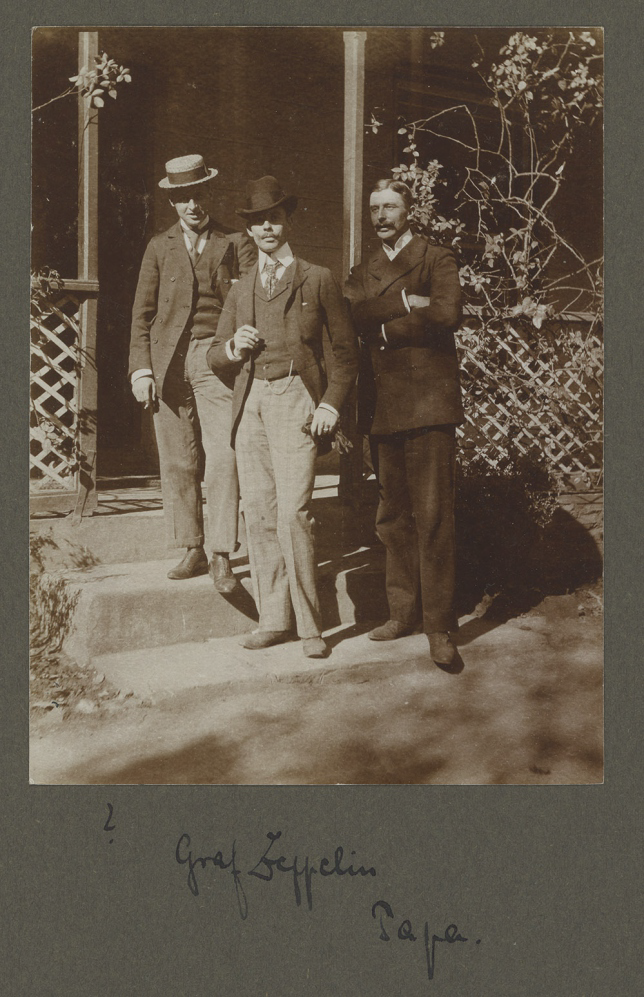
Wichmann and Graf Zeppelin
The cavalry pursuit was pressed home until complete darkness had set in.
Although they formed only a small portion of the Boer force, the Hollanders and the Germans suffered heavily. The wounded included Colonel Schiel who was taken prisoner. General Kock died at Ladysmith a few days after the battle. It was in that battle that the Hollanders and the Germans suffered heavy losses, and it would eventually cost the life of the Graf von Zeppelin. According to witnesses he had received a shot to the head and barely conscious also received a wound when cut by a sabre and stabbed with a lance by the cavalry of the enemy. He survived the night but died the next day. (http://samilitaryhistory.org/vol022ng.html)
After the defeat at Elandslaagte, General Joubert branded the Germans as cowardly fugitives. He collected them at Newcastle and sent them back to Johannesburg where they were, however, allowed to reorganise.
(http://www.ruralexploration.co.za/Heidelberg%2002.html)
Skirmishing between the British and the Boers, in which the German Commando played an outstanding part, took place until about 3 p.m. by which time all the British reinforcements had arrived. General French then decided to attack the Boer position in the few hours of daylight which remained. During the early skirmishing, the Germans were beaten back, and they withdrew into the hills to the north with the object of making their way back to the Boer position. Instead, they lost their way. They eventually found their bearings again and joined the Boer force when the battle was fully in progress. They were fired upon by the British, and by the Free Staters by mistake, when they suddenly came on to the left flank of the Boer line at about 5 p.m. – Text and photo SOURCE: angloboerwar.com

von Zeppelin grave
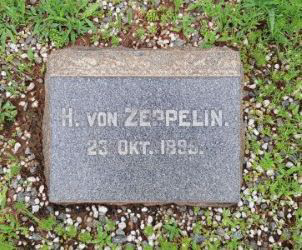
H Von Zeppelin, KIA on 23 Oct 1899 at Elandslaagte lies buried in the Heidelberg cemetery.
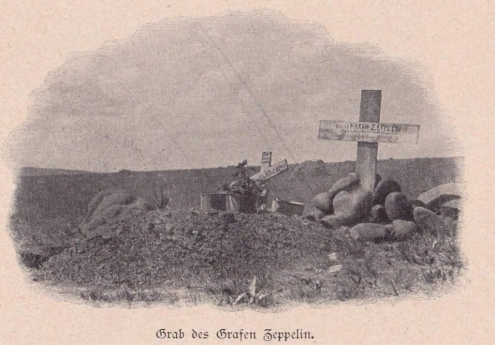
German postcard of Zeppelin’s grave
